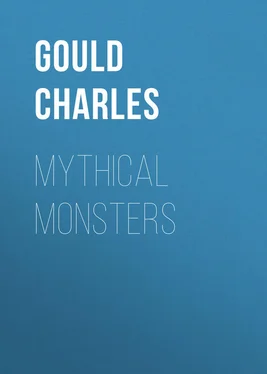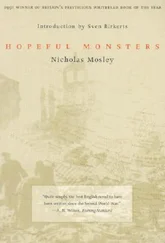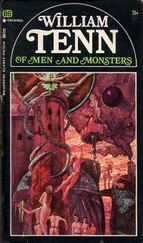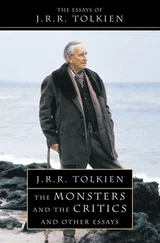Charles Gould - Mythical Monsters
Здесь есть возможность читать онлайн «Charles Gould - Mythical Monsters» — ознакомительный отрывок электронной книги совершенно бесплатно, а после прочтения отрывка купить полную версию. В некоторых случаях можно слушать аудио, скачать через торрент в формате fb2 и присутствует краткое содержание. Жанр: Мифы. Легенды. Эпос, Природа и животные, foreign_antique, foreign_prose, на английском языке. Описание произведения, (предисловие) а так же отзывы посетителей доступны на портале библиотеки ЛибКат.
- Название:Mythical Monsters
- Автор:
- Жанр:
- Год:неизвестен
- ISBN:нет данных
- Рейтинг книги:5 / 5. Голосов: 1
-
Избранное:Добавить в избранное
- Отзывы:
-
Ваша оценка:
- 100
- 1
- 2
- 3
- 4
- 5
Mythical Monsters: краткое содержание, описание и аннотация
Предлагаем к чтению аннотацию, описание, краткое содержание или предисловие (зависит от того, что написал сам автор книги «Mythical Monsters»). Если вы не нашли необходимую информацию о книге — напишите в комментариях, мы постараемся отыскать её.
Mythical Monsters — читать онлайн ознакомительный отрывок
Ниже представлен текст книги, разбитый по страницам. Система сохранения места последней прочитанной страницы, позволяет с удобством читать онлайн бесплатно книгу «Mythical Monsters», без необходимости каждый раз заново искать на чём Вы остановились. Поставьте закладку, и сможете в любой момент перейти на страницу, на которой закончили чтение.
Интервал:
Закладка:
The wolf, though greatly reduced in numbers during the Heptarchy, when Edgar laid an annual tribute of three hundred wolf-skins upon the Welsh, still occurred in formidable numbers in England in 1281, and not unfrequently until the reign of Henry VII. The last wolf was killed in Scotland in the year 1743, and in Ireland in 1770. 58
The wild cattle are now only represented by the small herds in Chartley Castle, Chillingham, and Cadgow parks; the spare survivors probably of the species referred to by Herodotus when he speaks of “large ferocious and fleet white bulls” which abounded in the country south of Thrace, and continued in Poland, Lithuania, and Muscovy until the fifteenth century, or perhaps of the Urus described by Cæsar as little inferior to the elephant in size, and inhabiting the Hercynian forest, and believed to be identical with the Bos primigenius found in a fossil state in Britain.
The wild boar was once abundant in Scotland and England. The family of Baird derives its heraldic crest from a grant of David I. of Scotland, in recognition of his being saved from an infuriated boar which had turned on him. In England only nobles and gentry were allowed to hunt it, and the slaughter of one by an unauthorized person within the demesnes of William the Conqueror was punished by the loss of both eyes. 59
The bustard, once abundant, is now extinct in Britain, so far as the indigenous race is concerned. Occasionally a chance visitant from the continent is seen; but there, also, its numbers have been greatly diminished. It was common in Buffon’s time in the plains of Poitou and Champagne, though now extremely rare, and is still common in Eastern Asia.
The capercailzie, or cock of the woods, after complete extinction, has been reintroduced from Norway, and, under protection, is moderately abundant in parts of Scotland.
In America, the process of extermination marches with the settlement of the various states. W. J. J. Allen records the absolute disappearance of the walrus from the Gulf of St. Lawrence, and of the moose, the elk, and the Virginian deer, from many of the states in which they formerly abounded. This also is true, to some extent, of the bear, the beaver, the grey wolf, the panther, and the lynx.
The buffalo ( Bos americanus ) is being destroyed at the rate of two hundred and fifty thousand annually, and it is estimated that the number slain by hunters for their hides during the last forty years amounts to four millions. It has disappeared in the eastern part of the continent from many extensive tracts which it formerly inhabited.
Among the ocean whales, both the right and the sperm have only been preserved from extinction by the fortunate discovery of petroleum, which has reduced the value of their oil, and thus lessened considerably the number of vessels equipped for the whale fishery.
In South Africa, elephants and all other large game are being steadily exterminated within the several colonies.
In Australia, we find that the seals which thronged the islands of Bass’s Straits in countless thousands, at the period when Bass made his explorations there, have utterly disappeared. The bulk of them were destroyed by seal-hunters from Sydney within a few years after his discovery. The lamentable records of the Sydney Gazette of that period show this, for they detail the return to port, after a short cruise, of schooners laden with from twelve to sixteen thousand skins each. The result of this has been that for many years past the number of seals has been limited to a few individuals, to be found on one or two isolated rocks off Clarke’s Island, and on Hogan’s group.
The great sea-elephant, which, in Peron’s time, still migrated for breeding purposes from antarctic regions to the shores of King’s Island, where it is described by him as lining the long sandy beaches by hundreds, has been almost unseen there since the date of his visit, and its memory is only preserved in the names of Sea-Elephant Bay, Elephant Rock, &c. which are still inscribed on our charts.
The introduction of the Dingo, by the Australian blacks in their southward migration, is supposed to have caused the extinction of the Thylacinus ( T. cynocephalus ), or striped Australian wolf, on the main land of Australia, where it was once abundant; it is now only to be found in the remote portions of the island of Tasmania. This destruction of one species by another is paralleled in our own country by the approaching extinction of the indigenous and now very rare black rat, which has been almost entirely displaced by the fierce grey rat from Norway.
We learn from incidental passages in the Bamboo Books 60that the rhinoceros, which is now unknown in China, formerly extended throughout that country. We read of King Ch’aou, named Hĕa (B.C. 980), that “in his sixteenth year [of reign] the king attacked Ts’oo, and in crossing the river Han met with a large rhinoceros.” And, again, of King E, named Sëĕ (B.C. 860), that “in his sixth year, when hunting in the forest of Shay, he captured a rhinoceros and carried it home.” There is also mention made – though this is less conclusive – that in the time of King Yiu, named Yeu (B.C. 313), the King of Yueh sent Kung-sze Yu with a present of three hundred boats, five million arrows, together with rhinoceros’ horns and elephants’ teeth.
Elephants are now unknown in China except in a domesticated state, but they probably disputed its thick forest and jungly plains with the Miaotsz, Lolos, and other tribes which held the country before its present occupants. This may be inferred from the incidental references to them in the Shan Hai King , a work reputed to be of great antiquity, of which more mention will be made hereafter, and from evidence contained in other ancient Chinese works which has been summarized by Mr. Kingsmill 61as follows: —
“The rhinoceros and elephant certainly lived in Honan B.C. 600. The Tso-chuen , commenting on the C‘hun T‘siu of the second year of the Duke Siuen (B.C. 605), describes the former as being in sufficient abundance to supply skins for armour. The want, according to the popular saying, was not of rhinoceroses to supply skins, but of courage to animate the wearers. From the same authority (Duke Hi XIII., B.C. 636) we learn that while T‘soo (Hukwang) produced ivory and rhinoceros’ skins in abundance, Tsin, lying north of the Yellow River, on the most elevated part of the Loess, was dependent on the other for its supplies of those commodities. The Tribute of Yu tells the same tale. Yang-chow and King (Kiangpeh and Hukwang), we are told, sent tribute of ivory and rhinoceros’ hide, while Liang (Shensi) sent the skins of foxes and bears. Going back to mythical times, we find Mencius (III. ii. 9) telling how Chow Kung expelled from Lu (Shantung) the elephants and rhinoceroses, the tigers and leopards.”
Mr. Kingsmill even suggests that the species referred to were the mammoth and the Siberian rhinoceros ( R. tichorhinus ).
M. Chabas 62publishes an Egyptian inscription showing that the elephant existed in a feral state in the Euphrates Valley in the time of Thothmes III. (16th century B.C.). The inscription records a great hunting of elephants in the neighbourhood of Nineveh.
Tigers still abound in Manchuria and Corea, their skins forming a regular article of commerce in Vladivostock, Newchwang, and Seoul. They are said to attain larger dimensions in these northern latitudes than their southern congener, the better-known Bengal tiger. They are generally extinct in China Proper; but Père David states that he has seen them in the neighbourhood of Pekin, in Mongolia, and at Moupin, and they are reported to have been seen near Amoy. Within the last few years 63a large specimen was killed by Chinese soldiery within a few miles of the city of Ningpo; and it is probable that at no distant date they ranged over the whole country from Hindostan to Eastern Siberia, as they are incidentally referred to in various Chinese works – the Urh Yah specially recording the capture of a white tiger in the time of the Emperor Süen of the Han dynasty, and of a black one, in the fourth year of the reign of Yung Kia, in a netted surround in Kien Ping Fu in the district of Tsz Kwei.
Читать дальшеИнтервал:
Закладка:
Похожие книги на «Mythical Monsters»
Представляем Вашему вниманию похожие книги на «Mythical Monsters» списком для выбора. Мы отобрали схожую по названию и смыслу литературу в надежде предоставить читателям больше вариантов отыскать новые, интересные, ещё непрочитанные произведения.
Обсуждение, отзывы о книге «Mythical Monsters» и просто собственные мнения читателей. Оставьте ваши комментарии, напишите, что Вы думаете о произведении, его смысле или главных героях. Укажите что конкретно понравилось, а что нет, и почему Вы так считаете.











